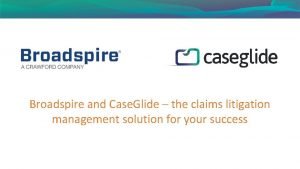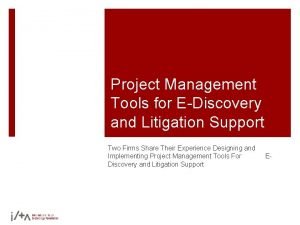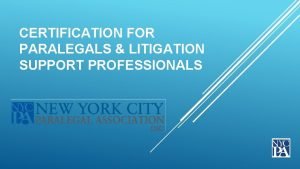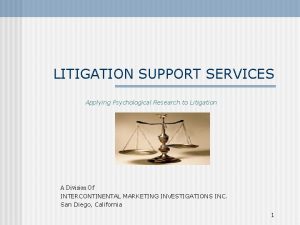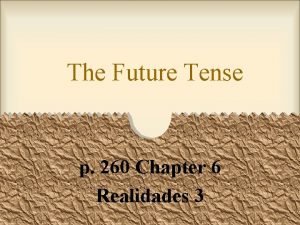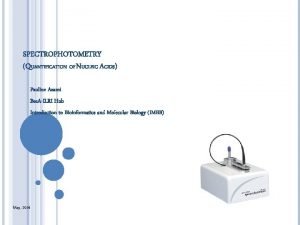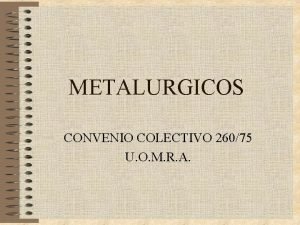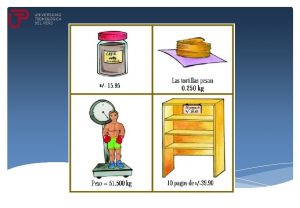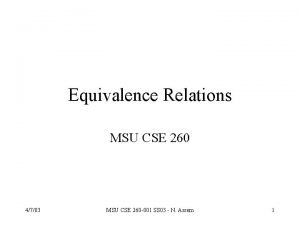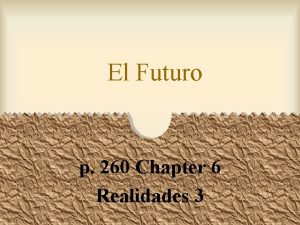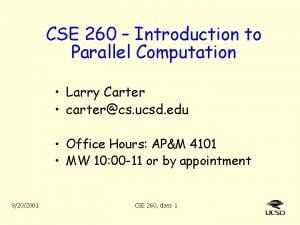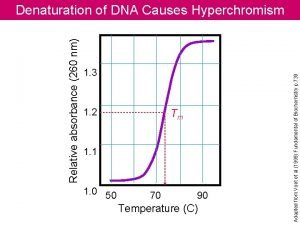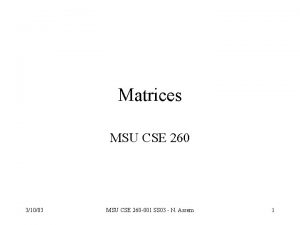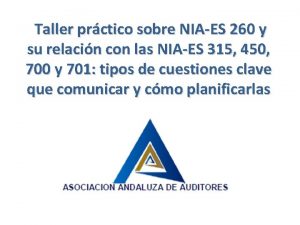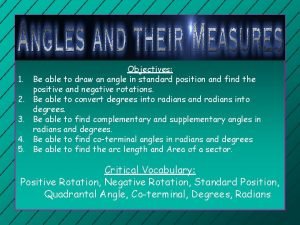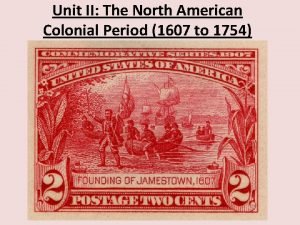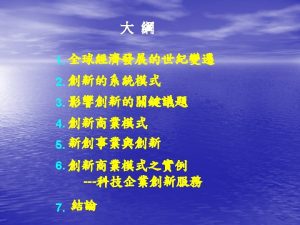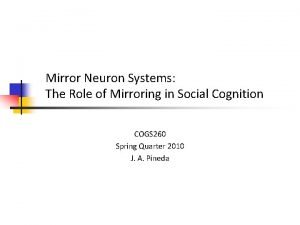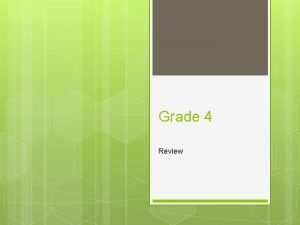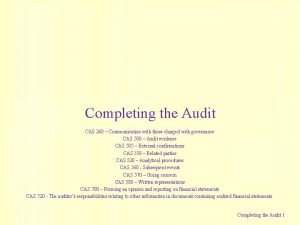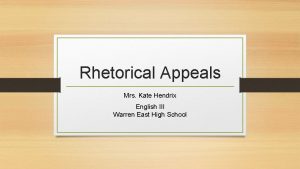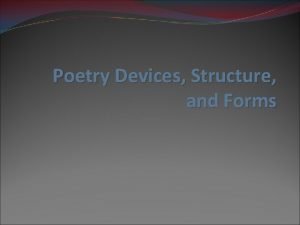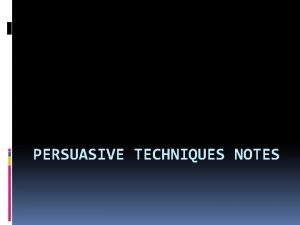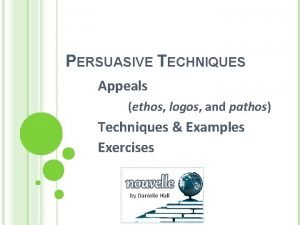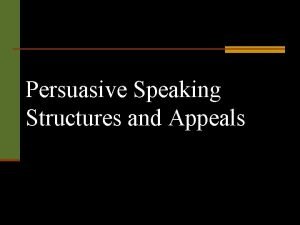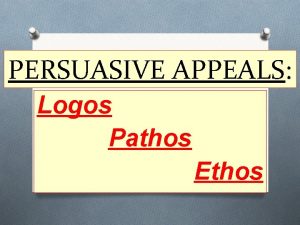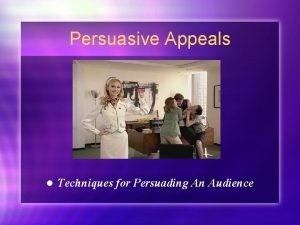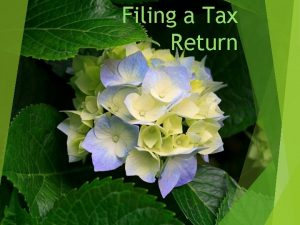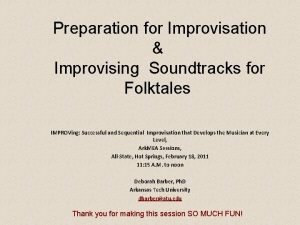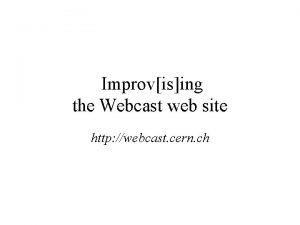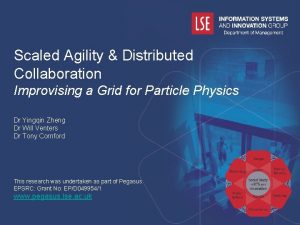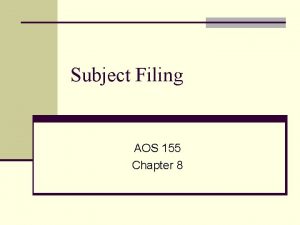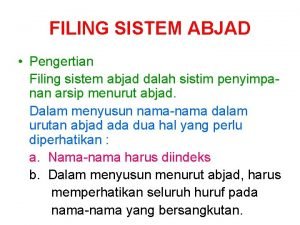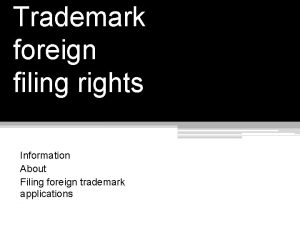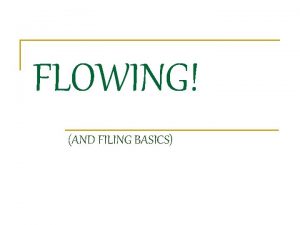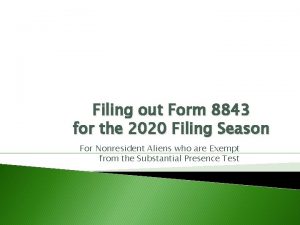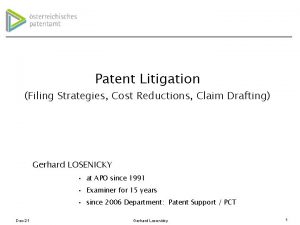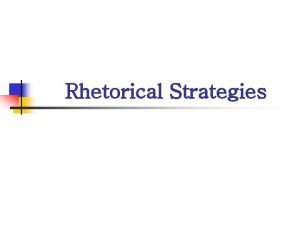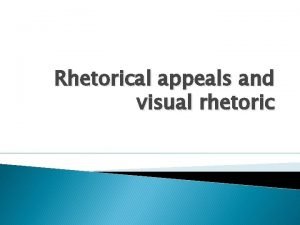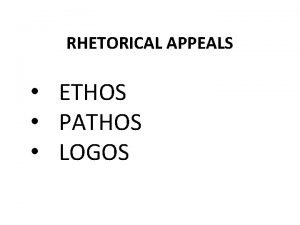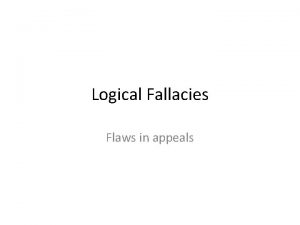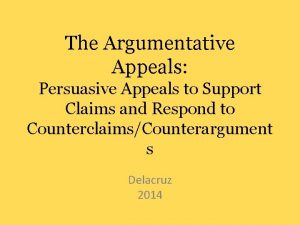Improvising Litigation Management Filing of appeals us 260








































- Slides: 40

Improvising Litigation Management (Filing of appeals u/s 260 A) Seminar on Management of Litigation & NJRS DTRTI Ahmedabad (28 -11 -2016)

Management 2 �The organization and coordination of the activities of a business in order to achieve defined objectives. � Management consists of interlocking functions of creating a policy and organizing, planning, controlling, & directing an organization's resources in order to achieve the objectives of that policy.

Litigation 3 �ORIGIN : lītigātiō (LATIN) a dispute � Ultimate legal method for settling controversies or disputes between and among persons, organizations, and the State. In litigation process, a case (lawsuit) is brought before a court of law suitably empowered (jurisdiction) to hear the case, by the parties involved (the litigants) for resolution (the judgment). �a legal proceeding in a court. �a judicial contest to determine and enforce legal rights.

Effects of Unresolved tax disputes 4 �Creates an un-certain business environment �Huge Tax revenue locked up in disputes for years �Affects the credibility of the tax administration (quick, consistent, transparent and fair the dispute resolution mechanism is in the eyes of the taxpayer) �Quality of the tax administration also affected by its ability to ensure that avoidable disputes do not occur/ not prolonged. �Protracted litigation =wasteful expenditure of time and resources �Detracts from voluntary compliance.

The Trigger points for Protracted Litigation 5 �Legislative ambiguity. �Legal provisions capable of multiple interpretations. �Lack of stakeholder participation during law making. �Retrospective amendments. �Asstt orders lacking in marshalling of facts/ evidences. �Asstt orders not in tune with judicial precedents. �Inadequate time for making assessment. �Inadequate training/industry experience of tax officers. �Overarching revenue collection targets.

The Trigger points… 6 �Revenue target linked performance evaluation. �Absence of revenue forecasting for annual targets. �Mechanism for dealing with audit objections. �Tendency to file appeals ignoring merit. �Limited reach of ADR forums. �Inadequate dispute prevention mechanism. �Lack of a comprehensive approach/strategy/concept of dispute management vis-à-vis dispute resolution.

The Initiatives - NLP 2010 7 �The National Litigation Policy 2010 was launched on 23. 06. 2010 was based on the recognition that the government and its various agencies are the predominant litigants in the court and the Tribunals in the country and aimed at reducing government litigation by transforming government into an efficient and responsible litigant. �The said policy however could not be implemented and is being reviewed and the revised policy is on the anvil. The policy aims to evolve mechanism to reduce pending litigation.

National Litigation Policy- 2010 8 Government must cease to be a compulsive litigant. The philosophy that matters should be left to the courts for ultimate decision, has to be discarded. The easy approach ‘let the court decide’, must be condemned. ” �“

Guidelines in NLP 2010 9 �Appeals in Revenue matters will not be filed: Ø If the stakes are not high and are less than that amount to be fixed by the Revenue Authorities; Ø If the matter is covered by a series of judgments of the Tribunal or of the High Courts which have held the field and which have not been challenged in the Supreme Court; Ø Where the assessee has acted in accordance with long standing industry practice; Ø Merely because of change of opinion on the part of jurisdictional officers.

Guidelines in NLP 2010 10 � Appeals will not be filed in the Supreme Court unless : Ø The case involves a question of law; Ø If it is a question of fact, the conclusion of the fact is perverse; Ø Where public finances are adversely affected; Ø Where there is substantial interference with public justice; Ø Where there is a question of law arising under the Constitution; Ø Where the High Court has exceeded its jurisdiction; Ø Where the High Court has struck down a statutory provision as ultra vires; Ø Where the interpretation of the High Court is plainly erroneous.

The Vision 2020 document 11 �It spells out the Vision, Mission, and Values of the department for the strategic plan for year 2011 to 2015 also espouse the cause of efficient and responsible litigation. �The vision 2020 document shows that the first step has been taken and action points formulated.

Vision, Mission & Values 12 Our Vision To partner in the nation building process through progressive tax policy, efficient and effective administration, and improved voluntary compliance.

Vision, Mission & Values 13 The following Mission statement outlines the roadmap to realize our vision: Our Mission To formulate progressive tax policies To make compliance easy To enforce tax laws with fairness To deliver quality services To continuously upgrade skills and build a professional and motivated workforce

Vision, Mission & Values 14 Our Values Will steer us through the journey towards realizing our Vision and will be reflected in all our decision making processes. Integrity (discharging our transparently) duties truthfully, honestly and Accountability Responsiveness (responsible for our actions and outcomes) Professionalism (sensitive, prompt, fair and objective in our dealings with our stakeholders, fostering mutual trust) Innovation (encourage new ideas, methods, processes and practices) Collaboration (work together with our stakeholders and partners to achieve common goals)

Initiatives 15 �The decision to file appeals before the High Courts is taken by a panel of CCs. IT ensuring more insightful vetting. �A collegium of CCs. IT to consider withdrawal of appeals filed by the Department from the High Courts in cases where no question of law is involved, issue is considered settled by the Department, or the appeal is no longer relevant in view of subsequent amendments. � NJRS has been launched and is expected to enable the field officers in identification of cases involving similar issues, bunching of such cases and pursuing the same for their early resolution.

Pendency of Appeals 16 S. N. As on Department’s Appeals Assessee's Appeal Total ITAT High Court Supreme Court 1 01. 04. 2013 24114 27185 5098 7890 5287 722 32004 32472 5820 2 01. 04. 2014 26321 30038 5149 8945 5663 811 35266 35696 5960 3 01. 04. 2015 26462 28468 4684 9006 4616 820 35468 33084 5504 26493 4515 8407 4457 678 74. 5% 85. 6% 87% 25. 5% 14. 4% 13% 4 30. 06. 2016 24590 Percentage 32997 30950 5193

Pendency of Appeals 17 30000 25000 20000 Revenus 15000 Assessees 10000 5000 0 ITAT HC SC

Disputed Demand in Appeals 18 DISPUTED DEMAND As On Revenue's Appeals Assessee's Appeals Rs. In lacs Total Disputed Demand ITAT High Court Supreme Court 30. 6. 2015 6524870 12919822 379602 8177962 274299 30887 14702832 13194121 410489 30. 6. 2016 7824444 17158868 1100665 7020113 193497 47842 14844557 17352365 1148507 Revenues Assessees

LITIGATION MANAGEMENT (Improving filing of appeals in ITAT & High Courts) 19 Ø SOP prescribed for filing appeals in ITAT & High Ø Ø Ø Court vide Instruction No. 7 & 8 of 2011. Monetary limits * prescribed for filing appeals vide Circular No. 21 of 2015. Order of CIT (A) pertaining to factual issues to be accepted, unless ‘perverse’. Appeals to ITAT & High Court not to be filed in a mechanical manner. Appeal to High Court only on ‘substantial question of law’. Consistency in interpretation of statute.

Monetary limits for filing of appeals (Circular No. 21/2015 dt. 10. 12. 2015) 20 Ø Supercedes earlier Instruction # 5/2014. Ø Revision as a measure for reducing Litigation. Ø Appeals should not be filed where the tax effect does not exceed the prescribed monetary limit. S. N. 1 2 3 Appeals in Income Tax matters Before ITAT Before High Court Before Supreme Court Monetary Limit (In Rs. ) 10, 000/ (4, 000) 20, 000/ (10, 000) 25, 000/ (25, 000/) Ø The PCIT to specifically record “ even though the decision is not acceptable, appeal is not being filed only on the consideration that the tax effect is less than the monetary limit specified in this instruction”. Ø No precedence value of such cases.

Circular No. 21/2015 21 Ø Exceptions to the rule – § Constitutional validity of the provisions are under challenge. § Board’s order, notification, instruction or circular are held illegal/ ultra-vires. § Revenue audit objection accepted by Department. § Addition relates to undisclosed foreign assets or bank accounts. Ø As evidence of not filing appeal due to this instruction may have to be produced in courts, the judicial folders in the office of PCIT must be maintained in a systematic manner for easy retrieval.

SOP on filing of appeals to ITAT (Instruction No. 8/2011 dated 11. 08. 2011) 22 Ø Jurisdictional Pr. CIT to decide whether to file appeal Ø Ø Ø in ITAT. Range Heads to ensure timely and proper filing of appeals by AO. Every appeal should be filed within 60 days of the receipt of CIT(A) order. Annexure-1 prescribes various stages and timelines for filing appeal. Annexure-2 is the proforma for scrutiny report on CIT(A) order. Officers concerned to clearly spell out the following issues :

SOP on filing of appeals to ITAT 23 § Facts of the case and basis of additions. § Reasons for granting relief by the CIT(A). § Reasons as to why the CIT(A) was not justified in recording the findings of fact or law. § How the CIT(A) order was perverse on facts. § Reasons for filing the appeal on each issue. § Grounds of appeal to clearly spell out the specific legal and factual issues being contested. § CIT(A) order not acceptable on merits but appeal not filed due to tax effect below the prescribed monetary limit. Ø A copy of scrutiny report to be sent to DR office for effective representation.

SOP on filing of appeals to High Court (Instruction No. 7/2011 dated 24. 05. 2011) 24 Ø Jurisdictional CCIT to decide whether to file appeal in High Court. Ø Jurisdictional Pr. CIT to ensure timely and proper filing of appeal. Ø Appeal should be filed within 120 days of the receipt of ITAT order. Ø Annx-1 prescribes various stages and timelines for filing appeal. Ø Annx-2 is the proforma for scrutiny report on ITAT order. Ø Annx-3 prescribes precautions to be taken to avoid defective appeals/objections being raised in filing appeals. Ø Annx-4 prescribes a register to be maintained by Pr. CIT to monitor the timely filing of appeal. Ø Annx-5 prescribes the quarterly report of appeals to be submitted by Pr. CIT/Pr. CCIT. Ø Appeal to be filed only on “substantial question of law”.

Timeline for filing appeals in the High Court (Instruction No. 6 of 2015) 25 SN Event Time allotted Total Days 1 Report from AO to Range Head 33 days 2 Range Head to the PCIT 10 days 43 days 3 PCIT to the CIT(Judicial) 15 days 58 days 4 Processing in O/o CIT (Judicial) 07 days 65 days 5 Approval by the CCIT 07 days 72 days 6 Downwards approval upto the AO 06 days 78 days 7 To St Counsel/ Drafting appeal memo/ Vetting/ Filing 260 A 42 days 120 days

SOP on submission of CSR (post circular 21/2015) 26 Ø No individual Central Scrutiny Reports are required to be sent. q Form A : Tabulates all appeals dismissed by ITAT due to tax effect being below monetary limit prescribed, even though the order of the ITAT is not acceptable in principle. q Form B : Tabulates all appeals where ITAT has inadvertently dismissed appeals citing low tax effect/ overlooked exceptions, intimating filing of Miscellaneous Application. q Form C : Tabulates all appeals decided in favour of the revenue and against the assessee.

Substantial Question of Law 27 Ø Not defined in IT Act or any other statute. Ø Analogous provision in Sec. 100 of CPC. Ø Tests laid down by the Constitution Bench in Sir Chunni Lal V. Mehta and Sons Ltd. Vs. Century Spinning & Manufacturing Co. Ltd. (AIR 1962 SC 1314) : § Whether the issue directly or indirectly affects substantial rights of the parties? § Whether the question is of general public importance? § Whether the issue has not been settled by any pronouncement of Supreme Court? § Whether the issue is not free from difficulty? § Whether it calls for a discussion for alternative views?

Perversity of Facts 28 Ø A wrong finding essentially on facts does not involve a substantial question of law, unless it is ‘perverse’. Ø “Perverse” : - - Contrary to accepted/ expected standards and practices. - Showing deliberate & obstinate desire to behave in an unreasonable/ unacceptable way.

Perversity of Facts 29 Ø Perversity of facts also constitutes ‘substantial question of law’. Ø Attributes of perversity laid down by Hon’ble Supreme Court in Sudarshan Silk & Sarees Vs. CIT (300 ITR 205). § The finding is without any evidence. § The finding is contrary to the evidence. § There is no direct nexus between the conclusion of fact and primary fact upon which that conclusion is based. § When an authority draws a conclusion which cannot be drawn by any reasonable person or authority on the material and facts placed before it.

Judicial Record Management System 30 Ø Essential for litigation management. Ø Prescribed in Instruction No. 7/2011 and 8/2011. Ø A separate judicial folder to be maintained by Pr. CIT for Ø Ø Ø each appeal filed by the Department or Assessee in ITAT. Further appeal to High Court and Supreme Court to be processed through this judicial folder. Appeal no. allotted by ITAT/High Court to be properly entered in the judicial folder. Digital copy of relevant documents – appeal memo with enclosures – to be maintained. Judicial folder to be transferred alongwith transfer of jurisdiction of assessee. Essential for successful implementation of NJRS.

Consistency in Interpretation of Statute 31 Ø Absence of a Departmental View on legal issues leads to litigation which undermines the confidence of taxpayers, increase the cost of compliance & adversely impacts the country’s development & investment climate. Ø Early identification of areas of contention & prioritization in formulating a Departmental View. Ø Strengthening Central Technical Committee & Regional Technical Committees to assist CBDT in the formulation of a ‘Departmental View’ on contentious issues. Ø Circulars incorporating ‘Departmental View’ to be brought out on a real time basis.

Central Technical C 0 mmittee & Regional Technical Committees 32 Ø CTC and RTC created vide Board’s O. M. (F. No. 279/M-61/ Ø Ø Ø 2012 -ITJ) dated 28. 08. 2012. CTC in CBDT and RTC in each Pr. CCIT Region. Committees formed to provide clarity on contentious issues, promote consistency and reduce litigation. RTC to meet atleast once a month to examine the issues referred and to further refer any issue to CTC, if required. CBDT to notify ‘Departmental View’ on contentious legal issues. Efforts to be made to strengthen and streamline the functioning of these committees.

COST AWARDED BY COURTS 33 Ø Strictures passed/cost awarded by Courts for filing appeal without application of mind & without necessary due diligence and caution. � Prescon Builders Pvt. Ltd. (ITAT, Mumbai ) the very fact that the AO filed the appeals without even verifying the year, which was mentioned in the ground of appeal, indicates that the appeals were filed in a routine manner which causes lot of inconvenience to the tax payers. � CIT -2 Vs. State Bank of India (Bombay High Court) Where the Revenue has accepted the order in the earlier year it should not challenge the subsequent order on the same issue. In case an appeal is preferred from the subsequent order, then the Memo of appeal must indicate the reasons as to why an appeal is being preferred in the later case. The absence of this being indicative of non-application of mind, does undoubtedly give an opportunity to the Revenue to arbitrarily pick and choose the orders of the Tribunal which they would challenge in the Appeal before the Court.

COST AWARDED BY COURTS 34 � A sensitive search case appeal was filed by the Department in High Court. The Registry pointed out certain defects in filing of appeal and the Court granted time to remove the defects in 2009. From 2009 till 2014, no follow-up action was taken and the case was dismissed due to default on part of the Department in curing procedural defects. � The Department filed a MA praying for restoration of the main appeal and subsequently a Review Petition which were dismissed by the Court. When the matter travelled to the Supreme Court, it has taken a serious view and directed that Department ascertain and fix responsibility of the individual(s) guilty of inaction and for taking appropriate action against them for such inaction. This default was compounded by the fact that the SLP was filed after a delay of 240 days. � Financial costs/Image of the Department/ Straining of its resources.

COST AWARDED BY COURTS 35 DIT (IT) v/s Credit Agricole Indosuez (Bombay High Court) v v Thus where the issue in controversy stands settled by decisions of this Court or the Tribunal in any other case and the Revenue has accepted that decision, then in that event the Revenue ought not to agitate the issue further unless there is some cogent justification such as change in law or some later decision of an higher forum etc. then in such cases appropriately the appeal memo itself must specify the reasons for preferring an appeal. Filing of appeal under Section 260 A of the Act is a serious issue. The parties who seek to file such appeals (which are normally after two tires of appeal before the Authorities under the Act) must do so after due application of mind and not raise frivolous / concluded issues. This is certainly expected of the State. The Registry has informed us that out of 4784 appeals from the order of the Tribunal filed in this Court during the period 01/01/2014 to 01/06/2014, the appeals filed by the Revenue are 3968, and only 816 by the class of Assessees as a whole.

COST AWARDED BY COURTS 36 �We direct the Registry and also the Counsel appearing for the Revenue to forward a copy of this order to CBDT. What could possibly be done is to provide an inhouse committee of senior officers of the Revenue to review decisions taken in respect of appeals already filed and pending. If it is found that questions raised are covered by any decision of this Court or Apex Court or it relies upon an earlier decision of the Tribunal which has been accepted by the Revenue as no appeal there from has been filed, then they could be separately classified. On completion of the above exercise such appeals could be either withdrawn and/or dismissed as not pressed.

COST AWARDED BY COURTS 37 Ø CIT vs Sairang Developers and Promoters Pvt. Ltd (Bombay High Court) ü High Court imposed costs of Rs. 50, 000 on AO for filing frivolous appeal & wasting public money & judicial time. Though the Bench clearly indicated to the department’s counsel that the appeal had no merit and gave the department an opportunity to withdraw, the department did not do so. ü “We do not find how Officers lower down in the hierarchy can take decisions to file Appeals and that too against the decision of the Tribunal. The tendency not to accept any adverse verdict on facts results in frivolous Appeals being filed in this Court. That causes huge loss to the public exchequer and results in wastage of precious judicial time of this Court.

COST AWARDED BY COURTS 38 ü The officials should realize that the authorities like CIT(A) and the ITAT are envisaged as appellate and possibly final fact finding authorities and at least the Tribunal is last in that hierarchy. The fact finding therefore if demonstrably perverse or palpably erroneous and as would amount to unsettling the settled position in law alone should be questioned by filing Appeals to this Court. ü However, a routine exercise and by people who do not wish to take any responsibility, results in number of Appeals being filed and pending. In these circumstances, while dismissing this Appeal, we impose costs quantified at Rs. 50, 000/. The costs be paid to the assessee within four weeks from today. We at least now expect the authorities to take cognizance and initiate proceedings for recovery of this amount personally from such of the Officers who do not take decisions or postpone them endlessly. A copy of this order be forwarded to the CCIT Pune.

My Take Away…… 39 �Ensuring strict compliance of time lines. � Ensuring check on Quality of proposals handled. � All relevant annexure are sent with the CSR. �Proper maintenance of Judicial records. �Look out for & feel proud of any Value Addition done by you.

THANK YOU 40
 Improvising a tourniquet
Improvising a tourniquet Caseglide
Caseglide Litigation project management
Litigation project management Association of litigation support professionals
Association of litigation support professionals Research & litigation support
Research & litigation support Pedir future tense
Pedir future tense 260/280 ratio
260/280 ratio Uomr
Uomr Dos cajas de galletas contienen en total 260 galletas
Dos cajas de galletas contienen en total 260 galletas Cse 260
Cse 260 El futuro (p. 260)
El futuro (p. 260) Ed 260
Ed 260 Ucsd cse 260
Ucsd cse 260 Amy gottfried umich
Amy gottfried umich 340 ucas points
340 ucas points 260 nm absorbance
260 nm absorbance Cse 260 msu
Cse 260 msu Reishauer rz 260
Reishauer rz 260 Si9a
Si9a What is hamlet's dying request of horatio?
What is hamlet's dying request of horatio? 370 en yakın yüzlüğe yuvarlama
370 en yakın yüzlüğe yuvarlama Hamlet act 5 scene 1 line 260
Hamlet act 5 scene 1 line 260 Zone of inhibition
Zone of inhibition 260 degrees in standard position
260 degrees in standard position English settlements in america
English settlements in america Msu cse 260
Msu cse 260 240 000
240 000 Mirroring 260
Mirroring 260 680 705 in expanded form
680 705 in expanded form Cas 260
Cas 260 What appeals to logic
What appeals to logic Kahoot rhetorical appeals
Kahoot rhetorical appeals Form and structure in poetry
Form and structure in poetry Emotional appeal examples
Emotional appeal examples Persuasive appeals
Persuasive appeals Persuasive techniques in writing
Persuasive techniques in writing Ethos persuasive technique
Ethos persuasive technique Problem solution persuasive speech
Problem solution persuasive speech Examples of logos appeal
Examples of logos appeal Ethos
Ethos Appeal persuasive technique
Appeal persuasive technique

